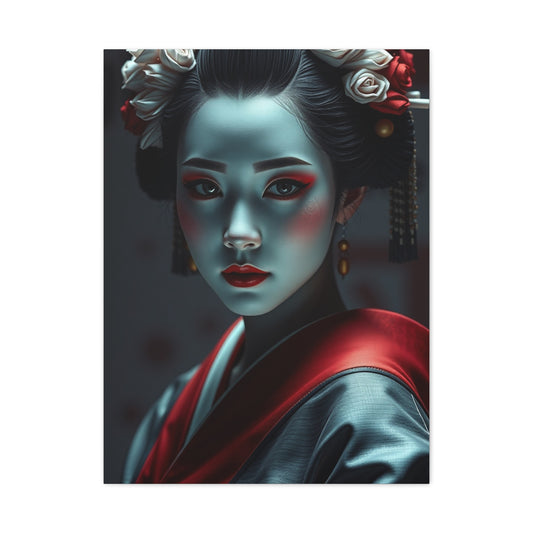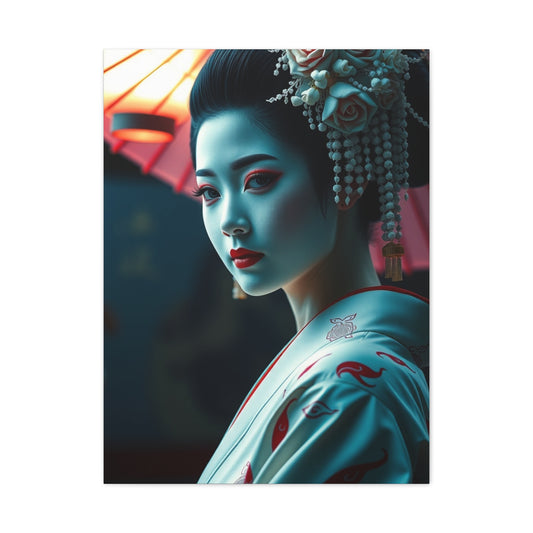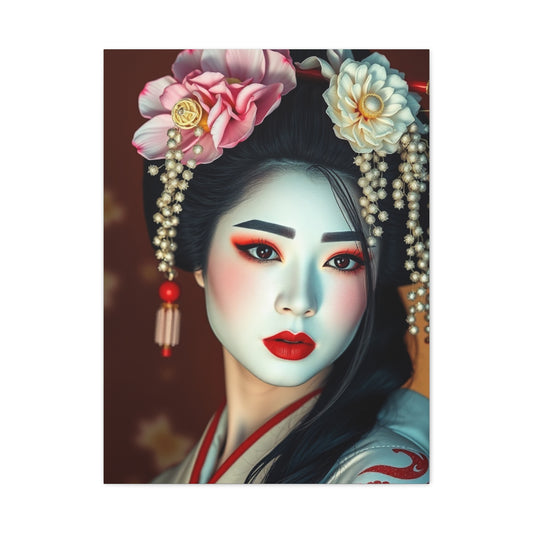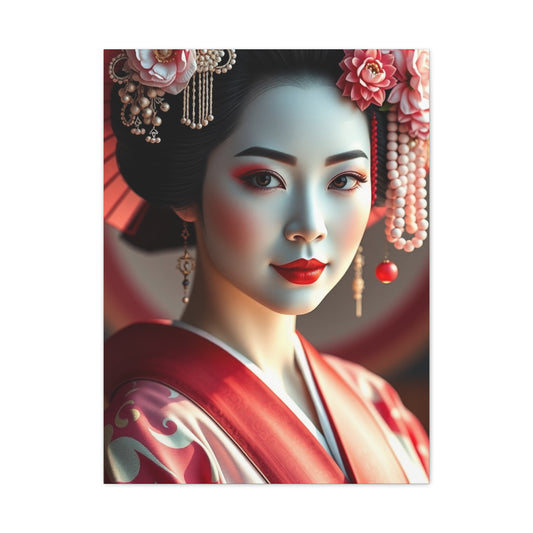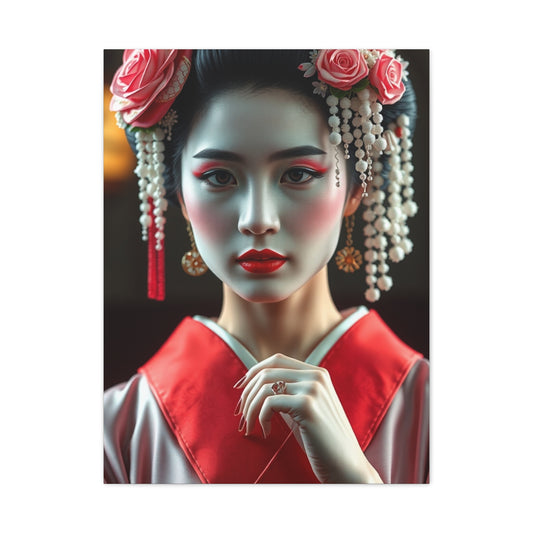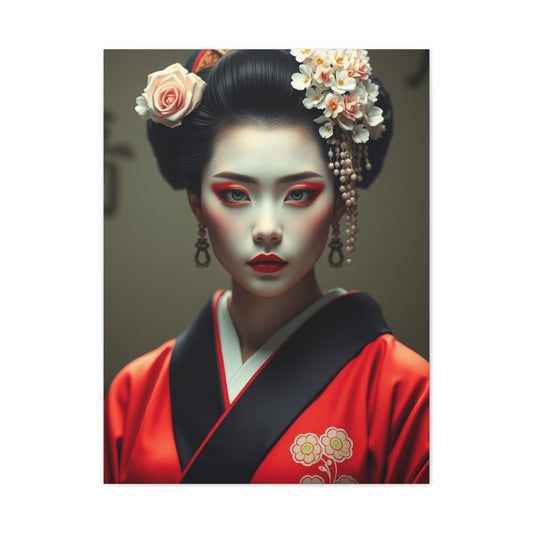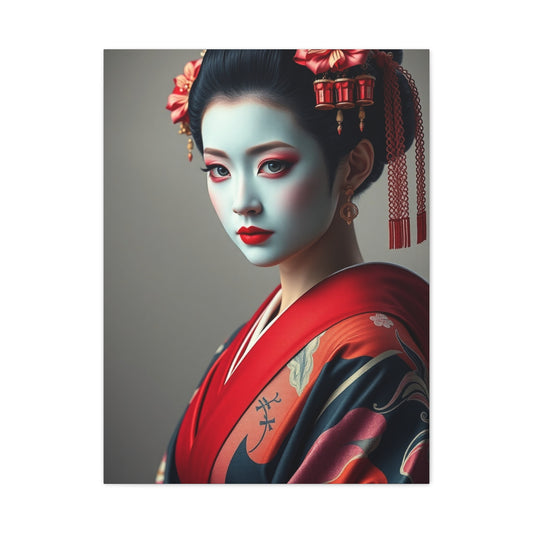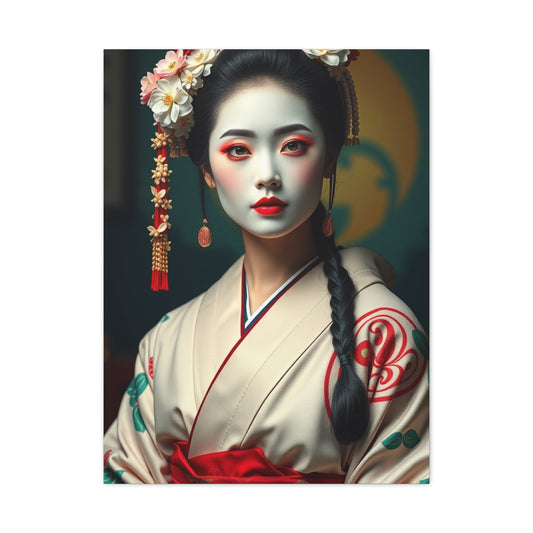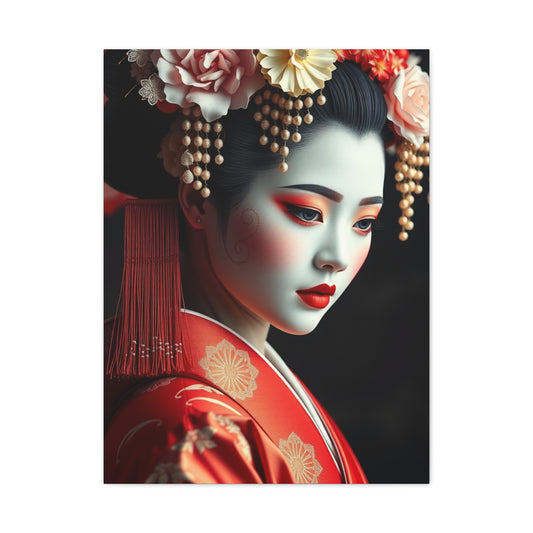How Geisha Wall Art Enhances Interior Beauty and Ambiance
Geisha wall decor has long captivated the imaginations of art enthusiasts and interior design aficionados alike. Steeped in tradition and cultural nuance, these artistic representations of geishas offer more than mere visual appeal; they encapsulate a refined aesthetic that merges elegance, serenity, and a distinct sense of heritage. The visual narrative within geisha art often extends beyond the figure itself, intertwining natural elements, intricate textile patterns, and subtle gestures that evoke an atmosphere of poise and refinement. The allure of geisha imagery lies in its ability to convey sophistication through delicacy, transforming a simple living space into an environment of artistic reverie.
The concept of geisha originates from Japan’s Edo period, where geishas were trained performers who mastered the art of music, dance, and conversation. Today, their portrayal in wall art emphasizes aesthetic grace, often highlighting traditional attire, elaborate hairstyles, and serene facial expressions. These images frequently feature geishas amidst landscapes of cherry blossoms, koi ponds, or tranquil interiors, creating compositions that exude both elegance and harmony. Such pieces of wall decor serve as an evocative portal into Japanese culture, allowing observers to experience a visual symphony of color, form, and tradition within the comfort of their own homes.
One of the most compelling aspects of geisha wall decor is its versatility in design and application. Contemporary interpretations of geisha art often blend classical elements with modern techniques, resulting in pieces that resonate with both traditionalists and modernists. Canvas prints, framed artworks, and tapestries can all feature geishas, each medium offering distinct textural qualities and aesthetic appeal. The choice of medium can influence the atmosphere of a room; a large canvas print can dominate a wall with striking visual intensity, whereas a delicate framed print may add understated charm and subtlety.
Color selection plays a crucial role in maximizing the impact of geisha art. The palette can range from soft pastels that evoke tranquility to vivid hues that command attention. For instance, a geisha adorned in a crimson kimono against a muted background can serve as a visual focal point, while a depiction rendered in soft lavender and ivory may seamlessly integrate into a minimalist or neutral-themed room. The juxtaposition of bright and subdued tones within geisha compositions allows for both dynamic visual contrasts and harmonious integration, offering endless possibilities for interior styling.
The intricacy of geisha imagery extends to the fine details that define each figure and environment. Patterns on kimonos, the subtle contours of a hand gesture, or the delicate positioning of hair ornaments are not merely decorative; they communicate aspects of grace, poise, and cultural symbolism. These subtleties enrich the viewer’s experience, inviting closer inspection and appreciation of the craftsmanship involved. Wall art depicting such nuances transforms ordinary walls into immersive storytelling spaces, where each piece tells a tale of elegance, tradition, and artistic mastery.
Geisha wall decor also offers a unique opportunity for thematic cohesion in interior design. A room adorned with geisha-inspired prints can establish a coherent cultural motif, reflecting an appreciation for Japanese artistry while providing a serene backdrop for daily life. Such decor can harmonize with other elements in the room, such as furniture, textiles, and lighting, to create a balanced aesthetic environment. The presence of geisha imagery often encourages contemplation and calm, reinforcing the notion that art in the home serves not just decorative purposes but also psychological and emotional enrichment.
Incorporating geisha artwork into a home extends beyond mere placement on a wall. The manner in which these pieces interact with space, light, and surrounding objects can dramatically influence the perception of a room. Positioning a large print opposite a source of natural light can enhance the vibrancy of colors, while framing choices can add depth and dimensionality. The orientation of the artwork—vertical or horizontal—also affects how the visual narrative is perceived, guiding the observer’s gaze along intended lines of movement or emphasis.
For those inclined toward DIY artistry, geisha wall decor provides a rich canvas for personal interpretation. Creating a geisha-inspired piece allows individuals to explore creative techniques such as painting, decoupage, or mixed media. Through personal artistic intervention, one can reinterpret traditional motifs, experiment with unconventional color palettes, or integrate modern elements, producing a unique piece that harmonizes with both the artist’s vision and the intended living space. Such customization imbues the artwork with a personal resonance, transforming it from a simple decorative object into an expression of individual creativity and cultural homage.
The narrative power of geisha imagery is closely tied to its ability to evoke emotion and introspection. The serene expressions, poised gestures, and flowing kimonos often convey tranquility, grace, and introspective beauty. This emotive quality distinguishes geisha art from other forms of decor, as it engages both the aesthetic and contemplative faculties of the observer. Walls adorned with these images can thus become reflective spaces, promoting relaxation, mindfulness, and appreciation of artistic subtlety.
Another noteworthy dimension of geisha wall decor is its adaptability across different interior styles. In minimalist settings, a single geisha print can punctuate a room with cultural elegance without overwhelming simplicity. In eclectic interiors, multiple geisha artworks can be layered with contrasting textures and patterns, contributing to a rich tapestry of visual interest. Similarly, in contemporary or modern interiors, geisha art can provide an intriguing juxtaposition, blending traditional motifs with sleek, modern furniture and decor to create a dialogue between past and present.
The thematic versatility of geisha art also extends to its depiction of seasonal and natural elements. Cherry blossoms, flowing rivers, autumn foliage, and bamboo groves frequently appear alongside geishas, creating compositions that celebrate the changing beauty of nature. These natural motifs not only enhance the visual richness of the artwork but also establish a sense of rhythm and continuity within a space, mirroring the cycles of nature and contributing to the overall ambience of serenity and balance.
Attention to scale, proportion, and placement remains essential when integrating geisha wall decor. Oversized pieces can dominate a room, drawing the eye immediately and establishing a central focal point, while smaller prints can complement existing decor or form part of a curated gallery arrangement. The spatial relationship between artworks, furniture, and architectural features influences how viewers interact with the images, allowing geisha art to function both as an anchor for interior design and as a subtle enhancer of overall aesthetic flow.
Furthermore, geisha wall decor offers opportunities for layering textures and materials. Canvas prints provide tactile richness and a painterly quality, while silk or fabric-based tapestries can introduce softness and a three-dimensional element. Framed artworks with glass or wooden frames offer a classic, refined finish that complements traditional interiors. By thoughtfully selecting medium and material, one can tailor the presence of geisha art to suit specific rooms, lighting conditions, and design intentions, ensuring that each piece resonates with its surroundings while retaining its own visual authority.
In essence, geisha wall decor embodies a harmonious synthesis of cultural heritage, artistic sophistication, and interior design versatility. Its enduring appeal lies in the subtle interplay of gesture, color, and pattern, which collectively evoke elegance, tranquility, and aesthetic enrichment. Whether deployed as a singular statement piece or integrated into a broader thematic arrangement, geisha art offers both visual allure and a connection to the rich traditions of Japanese artistry.
Embracing geisha wall decor is also an invitation to cultivate mindfulness in interior design. By thoughtfully selecting and positioning pieces that resonate with personal taste and spatial dynamics, homeowners can transform ordinary rooms into curated environments that reflect both aesthetic sensibility and cultural appreciation. Each artwork becomes a silent storyteller, narrating the grace, poise, and beauty of geishas while simultaneously enhancing the emotional and visual experience of the space it inhabits.
Ultimately, the charm of geisha wall decor extends beyond decorative appeal. It represents an intersection of artistry, cultural homage, and interior innovation, offering a unique avenue for personal expression. The presence of geisha imagery in a home contributes to a layered aesthetic experience—one that balances visual richness with contemplative elegance, and tradition with contemporary sensibility. As an artistic choice, geisha wall decor exemplifies the potential for art to transform living spaces, creating environments that are as inspiring as they are visually compelling.
The exploration of geisha art in home decor invites a deeper appreciation for the nuances of visual storytelling, the subtleties of gesture and expression, and the intricate interplay of color, pattern, and composition. By integrating these elements thoughtfully, a home becomes not just a place of habitation but a gallery of curated beauty and cultural resonance, where every glance at a geisha painting or print can spark reflection, admiration, and a profound sense of aesthetic satisfaction.
Selecting the Perfect Geisha Wall Decor for Your Space
Choosing geisha wall decor requires careful consideration of both aesthetic preferences and the characteristics of the intended environment. The process goes beyond simply selecting a visually appealing piece; it involves an understanding of scale, color, material, and thematic resonance. Each element contributes to the overall impact of the artwork within a room, ensuring that it complements and elevates the surrounding space while retaining its own visual identity.
The first step in selecting geisha artwork is to evaluate the room’s existing color palette. Geisha depictions often feature vibrant reds, delicate pastels, or muted earth tones. Aligning the artwork with the room’s hues enhances cohesion and prevents visual discord. For instance, a geisha adorned in a deep indigo kimono can provide a striking contrast against neutral walls, becoming a compelling focal point. Conversely, artworks with softer, monochromatic schemes can blend harmoniously with subdued interiors, contributing to an atmosphere of subtle sophistication. Thoughtful consideration of color ensures that the piece neither overwhelms nor underwhelms the space but integrates seamlessly into the overall design narrative.
Scale and proportion are equally critical in determining the success of geisha wall decor. Large-scale prints can dominate an empty wall, commanding attention and establishing a central visual anchor. These expansive pieces are particularly effective in living rooms or above beds, where they can draw the eye and establish a sense of grandeur. Smaller artworks, in contrast, are suited for more intimate spaces or can be combined to form curated gallery walls. Grouping multiple pieces creates a sense of continuity, allowing each artwork to contribute to a larger thematic tapestry without competing for prominence. The interplay between size and placement ensures a balanced composition, enhancing the room’s visual rhythm.
Material selection further influences the aesthetic and tactile qualities of geisha wall decor. Canvas prints, for example, offer a painterly texture that can accentuate brushstrokes and color gradients, imparting depth and richness. Framed prints provide a polished, classic finish that resonates with traditional interiors, while fabric or tapestry-based works introduce softness and dimension. Each medium interacts differently with light, texture, and surrounding furnishings, influencing both perception and ambiance. Consideration of material ensures that the artwork’s visual presence aligns with the room’s overall stylistic framework.
Artistic style is another decisive factor. Traditional depictions emphasize the historical and cultural aspects of geisha life, capturing precise details in attire, posture, and surroundings. These pieces evoke nostalgia and reverence, making them ideal for spaces designed to reflect cultural appreciation or historical elegance. Contemporary interpretations, on the other hand, may abstract or reimagine classical motifs, integrating geometric patterns, unconventional color schemes, or minimalist compositions. Such modern renditions can harmonize with sleek, contemporary interiors, creating a dynamic dialogue between tradition and innovation. Choosing a style that resonates personally and complements the room’s design ensures that the artwork contributes meaningfully to the space.
Lighting conditions play an essential role in highlighting the intricacies of geisha wall decor. Natural light can enhance the vibrancy of colors, revealing subtle tonal shifts and intricate details that might otherwise go unnoticed. Conversely, artificial lighting, strategically placed, can focus attention on specific features, such as the flowing lines of a kimono or the delicate expressions of a geisha’s face. Understanding how light interacts with the artwork at different times of day allows for optimal placement, ensuring the piece maintains its intended visual impact.
Thematic coherence is also significant when integrating geisha art into a space. Many geisha depictions incorporate natural elements such as cherry blossoms, bamboo groves, or flowing water. Selecting pieces that echo other aspects of the room—such as floral arrangements, wooden furnishings, or color accents—can create a harmonious environment where the artwork feels intrinsically connected to the surrounding decor. Conversely, juxtaposing geisha art with minimalist or neutral elements can provide a striking contrast, allowing the richness of the imagery to take center stage while maintaining balance within the overall design.
When considering multiple pieces of geisha art, composition and arrangement become paramount. Gallery walls allow for storytelling through spatial sequencing, where each piece contributes to a narrative of elegance, tradition, and aesthetic nuance. Varying frame sizes, orientations, and spacing can create a dynamic visual rhythm, inviting viewers to engage with each artwork individually while appreciating the collective ensemble. Thoughtful arrangement ensures that the presence of multiple artworks enhances the room’s ambiance rather than creating visual clutter.
DIY customization offers an additional layer of personalization. Reinterpreting geisha motifs through painting, mixed media, or decoupage allows homeowners to infuse individual creativity into the decor. Unique color combinations, alternative materials, or modern reinterpretations of classical poses can produce pieces that reflect personal taste while maintaining the aesthetic integrity of geisha imagery. Custom projects also provide an opportunity to explore different artistic techniques, creating artworks that are as expressive as they are decorative.
Texture and depth further influence the sensory experience of geisha wall decor. Canvas and oil paintings can impart a sense of tactility, inviting closer inspection of brushwork and surface variation. Tapestries or fabric-based artworks introduce softness and subtle movement, enriching the room’s sensory palette. Even subtle differences in frame materials—wood, metal, or lacquer—can influence how the piece interacts with its environment, enhancing perceived sophistication or complementing other design elements. The consideration of tactile qualities alongside visual appeal ensures a holistic approach to interior integration.
Color psychology also plays a subtle but meaningful role in geisha wall decor. Red and crimson tones evoke passion, energy, and vitality, often serving as attention-grabbing elements. Soft pinks, blues, or lavenders convey serenity, introspection, and gentle elegance, promoting calm and relaxation. Earth tones such as ochre, beige, and muted greens create a grounded, harmonious environment, linking the artwork to natural motifs often present in geisha compositions. Understanding these psychological effects can guide selection, allowing homeowners to choose artworks that not only enhance visual appeal but also influence mood and atmosphere.
In addition to visual considerations, cultural resonance is an essential aspect of selecting geisha wall decor. Each piece represents a connection to Japanese artistic traditions, embodying aesthetic principles such as wabi-sabi, which emphasizes the beauty of imperfection and transience, or ma, the concept of negative space and spatial harmony. Recognizing these cultural layers enriches the appreciation of geisha artwork, providing depth beyond decorative function and fostering an intimate connection with the artistic narrative embedded within each composition.
Placement strategies further refine the impact of geisha wall decor. Centralized positioning on a main wall can establish a commanding focal point, while asymmetrical placement can create visual intrigue and movement. Consideration of surrounding furniture, architectural features, and room flow ensures that the artwork interacts dynamically with the space, reinforcing balance and enhancing the aesthetic experience. Strategic placement also allows for optimal viewing angles, maximizing engagement and visual resonance.
For rooms with multiple functional zones, geisha wall art can act as both an aesthetic anchor and a spatial divider. In open-plan living areas, strategically placed artworks can delineate distinct spaces without physical barriers, while maintaining cohesive visual continuity. For instance, a large geisha canvas positioned between a dining and living area can unify the zones thematically while emphasizing cultural sophistication. The versatility of geisha art in spatial composition underscores its functional as well as decorative value.
Selecting complementary furnishings and decor elements enhances the overall effect of geisha wall art. Minimalist furniture, natural wood finishes, and subtle textiles can amplify the artwork’s elegance without competing for attention. Decorative objects such as vases, lanterns, or small sculptures can echo motifs in the artwork, reinforcing thematic cohesion and enriching the sensory landscape. By considering the broader interior ecosystem, homeowners can ensure that geisha wall decor contributes to a carefully curated, immersive environment.
Incorporating seasonal motifs within geisha artwork further enriches the interior experience. Cherry blossoms, bamboo shoots, flowing rivers, and autumn leaves frequently appear alongside geisha figures, each element evoking natural beauty and temporal change. Selecting pieces that reflect seasonal aesthetics can align interior decor with the rhythms of nature, promoting an ambiance of harmony, renewal, and contemplative beauty. Such integration highlights the dynamic relationship between artwork, environment, and lived experience.
Ultimately, selecting the perfect geisha wall decor involves a synthesis of aesthetic discernment, spatial awareness, cultural understanding, and personal taste. Every choice—from color palette and scale to material, style, and placement—contributes to a cohesive narrative that transforms walls into canvases of elegance, sophistication, and cultural resonance. By approaching selection with thoughtful intention, geisha wall decor becomes not only a visual delight but a reflection of curated sensibility, offering both artistic enrichment and interior refinement.
Integrating Geisha Wall Decor into Diverse Interior Styles
Geisha wall decor offers a unique opportunity to enrich interiors with a blend of cultural refinement and visual elegance. Its adaptability across various design styles makes it a versatile choice for both traditional and contemporary spaces. The key to successful integration lies in understanding how these artworks interact with the room’s overall aesthetic, creating a harmonious balance between cultural homage and personal expression.
In traditional interiors, geisha wall art enhances classical elegance. Rooms characterized by wooden furnishings, tatami-inspired textures, and muted earth tones naturally complement the intricate details and serene expressions of geishas. Here, the artwork serves as a visual anchor, reinforcing the room’s sense of historical and cultural continuity. Incorporating elements such as low wooden tables, shoji screens, and silk textiles alongside geisha depictions can create an immersive environment where every detail resonates with traditional Japanese artistry.
Minimalist interiors provide a contrasting but equally effective setting for geisha artwork. The simplicity and openness of such spaces allow a single geisha print or canvas to stand out, emphasizing its intricate details and vibrant colors. In this context, the artwork transforms from a decorative piece into a focal point that commands attention without overwhelming the room. The careful use of negative space, a principle aligned with Japanese aesthetics, enhances the elegance of the artwork, allowing viewers to appreciate subtle gestures, flowing kimonos, and the delicate interplay of color and form.
Eclectic interiors offer another avenue for showcasing geisha wall decor. By layering diverse textures, patterns, and colors, these spaces embrace visual complexity. Multiple geisha artworks can be arranged in a gallery wall, juxtaposed with other art forms or decorative objects to create a rich tapestry of visual interest. This approach encourages experimentation, allowing the observer to experience a dynamic interplay between classical motifs and modern design elements. The result is an interior that celebrates both artistic diversity and cultural reverence.
Modern and contemporary interiors benefit from the juxtaposition of geisha art against sleek, minimal furnishings. Clean lines, neutral color schemes, and geometric shapes provide a striking contrast to the organic forms and elaborate patterns characteristic of geisha depictions. This contrast enhances the artwork’s presence, creating visual tension that draws the eye while maintaining overall spatial harmony. Contemporary interpretations of geisha art, including abstract or stylized representations, can further complement such interiors, blending tradition with modern sensibilities to produce a sophisticated yet dynamic ambiance.
Lighting plays a pivotal role in integrating geisha wall decor across these diverse interior styles. Soft, diffused lighting accentuates subtle details and color transitions, enhancing the artwork’s sense of depth and dimensionality. Directional lighting can highlight specific features, such as the intricate folds of a kimono or the delicate posture of a geisha’s hand. Consideration of natural versus artificial light, along with strategic placement of fixtures, ensures that the artwork maintains its visual impact throughout different times of day, enhancing both functionality and aesthetic appeal.
Textural harmony is another crucial element. Canvas artworks introduce a painterly quality that complements tactile furnishings such as woven rugs or wooden surfaces. Framed prints offer refinement that aligns with polished, classic interiors, while fabric-based tapestries provide softness and movement, adding depth and sensory richness. By considering how textures interact, homeowners can create environments in which geisha art feels integral rather than imposed, enhancing the cohesion of the overall design.
Thematic cohesion extends beyond color and texture, encompassing the subject matter and associated natural motifs. Many geisha artworks feature cherry blossoms, bamboo groves, flowing water, or seasonal foliage, each contributing symbolic and aesthetic value. In interiors designed to reflect nature, such motifs reinforce a sense of tranquility and continuity, connecting the space to broader environmental and cultural narratives. Even in modern settings, these natural elements can provide balance, softening stark lines and creating a visual rhythm that resonates with the human eye.
Spatial arrangement and placement are essential considerations when integrating geisha wall decor. Oversized pieces can serve as central anchors, commanding attention and establishing focal points, while smaller works can be grouped to form curated gallery walls that encourage narrative exploration. Placement relative to furniture, architectural features, and traffic flow influences both the functionality and aesthetic impact of the artwork. Proper positioning ensures that each piece interacts dynamically with its surroundings, maintaining harmony while guiding visual engagement.
Color psychology contributes subtly yet powerfully to integration strategies. The rich reds and deep crimsons often present in geisha depictions evoke passion and vitality, making them ideal for spaces intended for social gatherings or creative endeavors. Softer pinks, blues, and lavenders promote calm and introspection, aligning with bedrooms, meditation spaces, or study areas. Earthy tones such as muted greens, beiges, and ochres create a grounded, harmonious environment, bridging the gap between natural motifs and interior decor. Understanding these effects enables homeowners to select artworks that enhance both aesthetic and emotional dimensions of their spaces.
In multi-functional interiors, geisha wall decor can delineate zones while maintaining visual unity. In open-plan living spaces, a strategically placed large canvas can define areas such as dining or lounge zones without interrupting the overall flow. Smaller artworks can be positioned to guide movement or highlight transitional areas, ensuring that the visual narrative remains cohesive across multiple functions. Such thoughtful integration elevates the utility of the artwork, transforming it into both a decorative and functional element within the interior.
Complementary furnishings and accessories further enhance the integration of geisha art. Minimalist furniture, natural wood finishes, and unobtrusive textiles allow the artwork to take center stage, while decorative objects such as vases, lanterns, or small sculptures can echo motifs found within the artwork. This layered approach creates continuity and reinforces thematic coherence, enriching the sensory experience of the interior. Each choice contributes to a holistic environment where geisha imagery feels organically connected to the room rather than superficially imposed.
The incorporation of seasonal motifs provides an additional dimension of integration. Geisha depictions featuring cherry blossoms, flowing water, or autumn foliage can align interior aesthetics with natural rhythms, creating a living space that evolves in harmony with the environment. Selecting artworks that reflect seasonal transitions introduces dynamic visual variation, reinforcing both aesthetic interest and a sense of temporal awareness. This approach imbues interiors with a living, breathing quality, enhancing the immersive power of geisha art.
DIY projects offer a further avenue for integration, allowing homeowners to reinterpret geisha motifs in ways that reflect their individual style and the character of the room. Techniques such as painting, decoupage, or mixed-media applications can produce personalized artworks that harmonize with existing furnishings and color schemes. Customization enables the creation of pieces that are not only visually appealing but also resonate with personal narratives, enriching the interior with layers of meaning and artistic intimacy.
Another aspect to consider is the interplay between geisha artwork and surrounding architectural features. Archways, alcoves, and textured walls can frame the artwork, enhancing its presence and visual impact. Conversely, flat, uninterrupted walls provide a blank canvas that allows the intricacy of the artwork to dominate attention. Recognizing how architectural elements influence perception allows for strategic placement, ensuring that the artwork integrates seamlessly while maintaining its intended narrative and aesthetic effect.
Layering of visual elements enhances the immersive quality of geisha wall decor. Combining prints, canvases, and tapestries in complementary arrangements creates depth and visual interest. The juxtaposition of different mediums and sizes introduces dynamism, encouraging the viewer to engage with the artwork from multiple perspectives. This approach transforms walls into curated galleries, where each piece contributes to a coherent narrative while maintaining its individual identity.
Cultural literacy adds further richness to integration. Understanding the symbolism of geisha attire, posture, and surroundings informs placement and pairing decisions. For instance, a depiction of a geisha amidst cherry blossoms may evoke themes of renewal and impermanence, suggesting placement in spaces dedicated to contemplation or relaxation. Recognizing these subtleties deepens the appreciation of the artwork and enhances its integration, ensuring that the interior reflects both aesthetic and intellectual engagement with the cultural source material.
Incorporating geisha art into eclectic or avant-garde interiors encourages creative tension. By juxtaposing classical motifs with modern or unconventional elements, homeowners can create interiors that challenge visual expectations while maintaining thematic resonance. This approach highlights the adaptability of geisha wall decor, demonstrating its ability to bridge cultural history and contemporary experimentation, producing spaces that are visually arresting and intellectually engaging.
Finally, the emotional resonance of geisha wall decor must guide integration decisions. These artworks evoke serenity, grace, and refined beauty, influencing the mood of the space. Strategic placement and thoughtful pairing with furniture, textiles, and lighting enhance this effect, ensuring that the room becomes more than a visual showcase—it transforms into a lived environment where art shapes daily experience, promotes mindfulness, and cultivates aesthetic enjoyment.
Ultimately, integrating geisha wall decor into diverse interior styles requires a combination of visual discernment, spatial awareness, and cultural sensitivity. Consideration of color, texture, scale, lighting, and thematic alignment ensures that each piece enhances the interior rather than competing with it. By approaching integration thoughtfully, homeowners can transform walls into immersive narratives of elegance, tradition, and artistic sophistication, creating interiors that celebrate the enduring beauty of geisha imagery while reflecting personal taste and spatial harmony.
Personalizing Spaces with DIY Geisha Wall Decor
Geisha wall decor offers abundant opportunities for personalization, allowing homeowners to infuse their interiors with individuality while honoring traditional artistry. Beyond the selection of pre-made prints and canvases, creating custom geisha-inspired artwork enables a more intimate connection with the space, transforming walls into reflections of both cultural appreciation and personal creativity. The process involves exploring materials, techniques, and design interpretations to craft pieces that are visually striking and emotionally resonant.
One of the primary approaches to personalizing geisha wall decor is through painting. Acrylics, watercolors, and oil paints each offer distinct qualities that can be leveraged to convey different aesthetic effects. Watercolors lend themselves to soft, flowing imagery, ideal for capturing the ephemeral grace of a geisha’s movements or the delicate petals of cherry blossoms. Acrylics provide versatility and vibrant coloration, suitable for bold, contemporary interpretations of traditional scenes. Oil paints, with their rich texture and depth, allow for intricate layering and nuanced shading, enhancing the realism and tactile presence of the artwork. Each medium offers a unique avenue for artistic expression, enabling homeowners to craft a visual language that aligns with both their style and the character of the room.
Decoupage is another compelling technique for creating customized geisha wall art. By layering printed images onto prepared surfaces, artists can manipulate composition, scale, and texture to produce singular interpretations of traditional motifs. Incorporating elements such as washi paper, fabric, or metallic accents can introduce additional depth and dimensionality, bridging the gap between classical aesthetics and modern design sensibilities. Decoupage allows for experimentation with mixed-media effects, fostering originality while maintaining the elegance characteristic of geisha imagery.
Mixed-media applications expand the possibilities of DIY geisha decor even further. Combining paint, collage, textiles, and natural materials can produce dynamic, multi-layered pieces that engage both visual and tactile senses. For instance, incorporating silk threads to emulate the flowing patterns of a kimono or embedding pressed flowers to echo seasonal motifs can enhance the artwork’s sensory richness. This approach transforms a wall from a static surface into a multi-dimensional canvas, inviting closer inspection and prolonged engagement.
Personal reinterpretation of geisha imagery is a particularly powerful avenue for DIY projects. While classical depictions emphasize historical accuracy in posture, attire, and setting, modern reinterpretations can abstract forms, manipulate colors, or introduce minimalist or surreal elements. This creative freedom allows the artwork to resonate with contemporary interiors while retaining cultural references. Abstracted kimonos, geometric backgrounds, or stylized facial features can produce visually arresting pieces that both honor tradition and reflect individual artistic sensibilities.
Custom framing and presentation further personalize the geisha wall decor. The choice of frame—wood, metal, lacquer, or even fabric-wrapped—can complement the artwork while influencing its visual impact. Framing can create contrast, highlight textures, or introduce a subtle element of sophistication. For larger projects, wall-mounted panels or shadowboxes can be employed, providing depth and dimensionality that transform a simple artwork into an immersive installation. Presentation techniques allow for fine-tuning of both aesthetic appeal and spatial harmony.
Thematic cohesion is essential when integrating DIY geisha pieces with existing decor. Artists can select motifs and color palettes that harmonize with the room, ensuring that the custom work enhances rather than clashes with its surroundings. Subtle references to existing furnishings, textiles, or architectural elements can be incorporated into the artwork, creating a visual dialogue that unifies the space. For instance, a geisha piece featuring muted greens and earth tones can echo wooden furniture or indoor plants, reinforcing a cohesive interior narrative.
Lighting considerations also influence the effectiveness of personalized geisha wall art. Natural light accentuates brushstrokes, textures, and tonal subtleties, revealing details that might otherwise remain unnoticed. Artificial lighting, strategically placed, can highlight focal areas or create dramatic shadows, enhancing the perception of depth and dimensionality. Experimenting with placement and illumination ensures that custom artwork maintains its intended visual impact while interacting dynamically with the room’s overall ambiance.
DIY geisha projects also allow for playful exploration of scale and composition. Large-scale murals can dominate a wall, establishing a bold focal point that transforms the space, while smaller, multi-panel arrangements encourage nuanced engagement and gallery-style storytelling. Consideration of proportion, spacing, and alignment ensures that each piece contributes to a cohesive visual rhythm, allowing the viewer to experience the artwork both individually and as part of a broader thematic ensemble.
In addition to painting and mixed-media techniques, digital tools offer another avenue for personalizing geisha wall decor. Digital illustration and graphic design programs enable manipulation of color, composition, and texture in ways that are difficult to achieve through traditional media. Prints derived from digital creations can be scaled, layered, and printed on a variety of surfaces, from canvas to fabric, allowing for versatility in placement and integration. This approach merges contemporary technology with classical motifs, creating unique pieces that reflect modern sensibilities while retaining cultural resonance.
Seasonal and natural motifs are often central to personalized geisha artwork. Cherry blossoms, flowing water, bamboo groves, and autumnal foliage can be reinterpreted to align with the artist’s vision or the room’s design. Incorporating these elements adds layers of symbolism and visual interest, creating compositions that are both aesthetically pleasing and contextually meaningful. Seasonal motifs also offer opportunities for dynamic variation; rotating or modifying artwork over time can refresh the visual character of a space while maintaining continuity with thematic elements.
Personalization also extends to thematic experimentation. Geisha motifs can be blended with abstract patterns, contemporary geometric shapes, or surreal landscapes to produce unconventional interpretations. These creative choices allow homeowners to imbue walls with a distinctive artistic voice, reflecting both individual taste and an informed understanding of traditional imagery. The juxtaposition of classical elegance with modern innovation produces visually stimulating results that challenge expectations while celebrating cultural artistry.
DIY geisha wall decor fosters an intimate connection with the creative process itself. By engaging with color, form, and material, the artist develops a deeper appreciation for the subtleties inherent in traditional Japanese imagery. The act of creating, whether through painting, decoupage, or mixed media, becomes a meditative practice, enhancing mindfulness and offering a sense of accomplishment. This personal involvement imbues the finished artwork with meaning beyond visual appeal, transforming it into a reflection of artistic intent and lived experience.
Collaborative DIY projects can further enrich the integration of geisha artwork. Working with family members, friends, or local artisans encourages the exchange of ideas, techniques, and interpretations, resulting in multi-layered creations that reflect diverse perspectives. Such collaborative efforts introduce social and emotional dimensions to the artwork, fostering connection and dialogue through the medium of artistic expression.
Textural exploration is a particularly effective tool for personalizing geisha wall decor. Layering paint, fabric, paper, or other materials introduces a tactile dimension that engages multiple senses. Raised surfaces, embossed patterns, or fabric appliques can mimic the intricacies of kimono designs, enhancing realism while adding depth. Attention to texture ensures that the artwork interacts dynamically with light and perspective, creating a captivating presence that draws the observer into the composition.
Integration of cultural symbols within DIY geisha projects adds further resonance. Subtle references to traditional practices, seasonal changes, or historical context can enrich the narrative quality of the artwork. These elements provide a bridge between visual aesthetics and cultural storytelling, allowing the wall decor to function not merely as decoration but as an immersive cultural experience. By thoughtfully incorporating symbolism, artists can craft pieces that are intellectually engaging as well as visually striking.
Personalized geisha wall decor can also experiment with unconventional formats. Folding screens, hanging scrolls, and multi-panel installations provide alternative display methods that introduce movement, rhythm, and spatial dynamism. These formats allow for flexible interaction with the space, enabling homeowners to adapt the artwork to room configuration, lighting conditions, and functional requirements. Exploring diverse formats broadens creative possibilities and enhances the overall impact of the wall decor.
Finally, the act of creating personalized geisha artwork cultivates a deeper appreciation for the interplay of tradition and innovation. Each decision—whether in color, medium, texture, or composition—reflects an understanding of classical motifs while embracing contemporary artistic freedom. This synthesis produces unique artworks that resonate with both cultural authenticity and individual expression, enriching the interior environment and elevating the role of wall decor from mere ornamentation to a meaningful element of aesthetic and emotional experience.
By engaging with DIY techniques, homeowners transform geisha wall decor into a medium for personal storytelling, cultural exploration, and artistic experimentation. From hand-painted canvases to layered mixed-media creations, each piece reflects thoughtful consideration, creative intent, and intimate connection with the space it inhabits. Personalized geisha artwork thus transcends its decorative function, becoming an integral component of interior identity, visual narrative, and emotional resonance.
Enhancing Ambiance and Sustaining Elegance with Geisha Wall Decor
Geisha wall decor serves as a profound tool for transforming interior spaces, merging aesthetic beauty with cultural resonance. Beyond visual appeal, these artworks cultivate atmosphere, guide emotional tone, and reinforce the identity of a room. Understanding how to enhance ambiance with geisha art involves careful attention to placement, pairing, lighting, and ongoing care, ensuring that the artwork remains a central, harmonious element within the living environment.
One of the most immediate effects of geisha wall decor is the creation of ambiance. The serene expressions, graceful postures, and flowing garments depicted in these artworks naturally evoke calm and refinement. Walls adorned with geisha imagery can transform bustling living spaces into environments of contemplation, promoting mindfulness and relaxation. This quality makes geisha art particularly well-suited for bedrooms, meditation areas, or reading nooks, where emotional tranquility is a desired characteristic.
Lighting plays a pivotal role in enhancing the impact of geisha wall decor. Soft, ambient illumination can highlight the delicate nuances of a geisha’s pose, the subtle gradients of a kimono, or the intricacy of surrounding natural motifs. Directional or spotlighting can emphasize focal points, drawing the viewer’s attention to key elements and creating depth and dimensionality. Adjusting lighting according to time of day allows for dynamic engagement, transforming the visual perception of the artwork and amplifying its contribution to the room’s mood.
Color harmonization further influences ambiance. Geisha artworks feature diverse palettes ranging from vivid reds and deep indigos to muted pastels and earthy neutrals. Matching or contrasting these colors with surrounding furnishings, wall finishes, and decorative accents can either anchor the space or create visual dynamism. Bold color choices often energize a room, making it more vibrant and engaging, while subdued palettes establish serenity, blending seamlessly with minimalist or neutral interiors. Careful consideration of color ensures that geisha art enhances the desired emotional and visual tone of the room.
Incorporating multiple pieces of geisha art encourages narrative layering within a space. Arranging several artworks as a gallery wall or in a thematic sequence creates a visual story, inviting viewers to explore the subtle details and relationships between compositions. The narrative dimension of geisha art—gestures, seasonal settings, or expressions—enhances the experiential quality of the interior, transforming walls into immersive storytelling surfaces. Grouping works strategically can also reinforce thematic consistency, ensuring that the artwork integrates with furniture, textures, and architectural features.
Thematic pairing with other decor elements is another effective method for amplifying ambiance. Geisha art harmonizes naturally with elements such as low wooden furniture, paper lanterns, silk cushions, or floral arrangements. Subtle repetition of motifs or colors creates a cohesive aesthetic, reinforcing the sense of harmony and cultural continuity. In modern or eclectic spaces, pairing geisha artworks with minimalist, geometric, or contemporary elements produces a compelling contrast, highlighting the elegance and intricacy of the traditional motifs while maintaining a balanced interior composition.
Texture plays a critical role in sustaining visual interest and enhancing ambiance. Canvas, wood, and fabric-based artworks each contribute distinct tactile and optical qualities. Canvas prints emphasize brushwork and depth, wooden frames introduce solidity and warmth, while textile or tapestry pieces add softness and dimensionality. Combining textures thoughtfully within a room creates a multi-sensory experience, elevating the visual presence of geisha art while encouraging interaction and engagement.
Scale and proportion remain essential for optimizing the impact of geisha decor. Oversized pieces can dominate a focal wall, providing a commanding presence that transforms the room’s atmosphere. Smaller pieces, when grouped or layered, contribute subtle complexity, drawing the viewer in for closer examination. By considering scale relative to furniture, room size, and visual flow, homeowners ensure that the artwork integrates naturally, enhancing ambiance without overwhelming the space.
Seasonal motifs embedded in geisha artwork offer further opportunities to enrich interior environments. Cherry blossoms, bamboo groves, flowing water, and autumn leaves not only provide aesthetic beauty but also evoke temporal awareness and natural rhythm. Selecting artworks that correspond to seasonal changes can subtly alter the room’s atmosphere throughout the year, promoting an evolving visual and emotional experience. Seasonal alignment encourages a living, breathing quality within the space, fostering connection with natural cycles and cultural symbolism.
Maintenance and care are critical for preserving the elegance of geisha wall decor. Canvas artworks benefit from avoiding direct sunlight, which can cause fading, while fabric-based pieces require occasional dusting and gentle handling to prevent wear. Framed artworks should be kept away from excessive moisture and cleaned with appropriate materials to maintain clarity and vibrancy. Regular attention ensures that the artwork continues to enhance the ambiance over time, retaining both aesthetic and cultural integrity.
Custom arrangements and DIY projects can further sustain individuality and ambiance. Personalized geisha art—whether hand-painted, decoupaged, or digitally rendered—introduces unique visual narratives and emotional resonance. By integrating these custom creations into the interior thoughtfully, homeowners maintain a distinct, personalized identity within the space. Such engagement fosters pride in the living environment while reinforcing a meaningful connection to the cultural artistry represented in the artworks.
Geisha wall decor also allows for strategic interaction with architectural features. Alcoves, niches, archways, and textured walls can frame artwork, enhancing visual prominence and guiding gaze. Conversely, blank walls serve as minimalist canvases, allowing the artwork’s intricacies to dominate attention. Recognizing how architectural elements shape perception enables effective placement, maximizing both visual and emotional impact while reinforcing spatial harmony.
In addition to individual pieces, geisha-themed room planning encourages holistic design. Coordinating wall decor with textiles, flooring, and furniture creates a unified environment. For example, pairing a geisha painting with silk cushions or tatami-inspired rugs establishes cohesion and accentuates the cultural narrative of the room. Such integration transforms the space from a simple assemblage of objects into an immersive environment where every element contributes to a deliberate aesthetic experience.
Layering artworks of varying scale and medium further enriches the ambiance. Combining prints, tapestries, and framed works introduces depth and visual rhythm, inviting prolonged observation and interaction. Multi-panel or modular arrangements can guide the eye through the room, creating a dynamic narrative journey. This layered approach encourages a more engaging and multidimensional experience, where the viewer can appreciate both individual pieces and their collective impact.
Cultural awareness enhances the interpretation and integration of geisha wall decor. Understanding the symbolism of posture, attire, seasonal motifs, and spatial arrangements informs placement and pairing choices. This awareness allows for a deeper connection with the artworks, ensuring that the room reflects both visual sophistication and informed appreciation of Japanese artistic traditions. Integrating cultural context into design decisions elevates the interior from decoration to storytelling, enriching the observer’s experience.
Balancing traditional and contemporary elements further sustains elegance. Geisha artworks can coexist with modern furniture, minimalistic lighting, and geometric accents, creating a dialogue between past and present. This fusion encourages visual tension that highlights the intricacy of the artwork while promoting cohesion with the overall design. Contemporary reinterpretations of geisha motifs—such as stylized forms, abstract backgrounds, or monochromatic palettes—blend seamlessly with modern interiors while honoring classical inspiration.
Spatial dynamics are critical for long-term aesthetic balance. The positioning of geisha artwork relative to windows, doors, and focal points influences the perception of scale, depth, and movement within the room. Proper alignment ensures that the artwork anchors the space effectively, harmonizing with both functional flow and visual narrative. Regular reassessment of placement allows for adaptation as interior arrangements evolve, maintaining the artwork’s prominence and relevance over time.
Interactive design strategies enhance engagement with geisha wall decor. Placing artwork at eye level encourages direct visual interaction, while grouping pieces to create thematic sequences invites narrative exploration. Complementary elements such as plants, textiles, or decorative objects can echo motifs, reinforcing continuity and encouraging closer engagement. Thoughtful curation ensures that geisha wall art becomes a living component of the interior, continually shaping perception and experience.
Finally, the emotional resonance of geisha art must guide long-term integration. Beyond aesthetics, these artworks evoke grace, serenity, and contemplative beauty, influencing the mood and energy of a room. By selecting pieces that align with the intended emotional tone—whether tranquil, energizing, or introspective—homeowners can harness geisha art to cultivate atmosphere intentionally. This consideration transforms wall decor into a purposeful tool for shaping both visual and emotional dimensions of the living space.
Conclusion
Geisha wall decor offers a unique fusion of elegance, cultural depth, and artistic sophistication, transforming ordinary interiors into spaces of visual and emotional resonance. Through careful selection, integration, and personalization, these artworks can complement a wide range of interior styles—from traditional Japanese-inspired rooms to minimalist or contemporary spaces—while maintaining thematic and aesthetic harmony. The interplay of color, texture, scale, and placement enhances ambiance, guiding mood and perception, while seasonal and natural motifs enrich the narrative and symbolic depth of each piece. DIY projects and custom interpretations allow homeowners to infuse personal creativity, creating truly unique artworks that reflect both individual taste and cultural appreciation. Ultimately, geisha wall decor transcends decorative function, becoming a medium of storytelling, mindfulness, and refined beauty. Its presence cultivates serenity, elegance, and artistic expression, ensuring that every space it inhabits is both visually captivating and emotionally inspiring.

